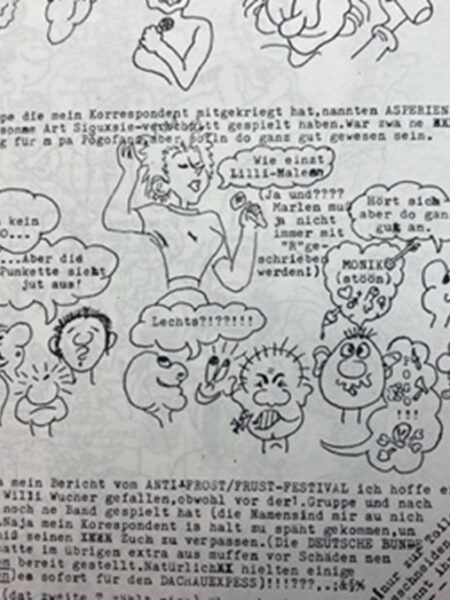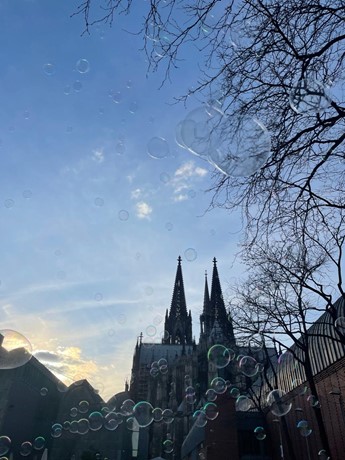Introduction
What does one see when looking at Europe? Is it its geographical landscapes, its political borders, its opportunities, or a combination of all these elements? There is no set answer to these questions, nor is there one single way of deciphering what Europe is. The continent is home to forty–six states, twenty–seven of which are members of the European Union, (Council of Europe data). The overarching presence of the continent’s political body shapes much of what is canonically understood by “Europe,” as continent itself is often equated with the EU. However, Europe is much more than its unified political structure: countless languages and traditions coexist not just within the continent but within single countries, as millennia of culture have shaped Europe’s citizens and their ways of life. Europe is also home to a host of contradictions, as it praises inclusion but actively fosters exclusionary policies by reinforcing its steel borders. Tied to this issue is an ongoing debate on the concept of “European identity”, which is exasperated by Europe’s other major and ongoing debate on migration and migratory movements (El–Tayeb 2008). Ever since the end of the Cold War, the EU has fashioned itself as a post–national entity based on common values, shared interests, advantageous economy and facilitated mobility. This is exemplified by the widespread usage of the Euro as currency, for instance, or by mobility policies, which allow EU citizens to move freely within Europe with no need for visas. While this outlook is positive, these progressive stances are only directed towards those who already operate within the EU’s borders, systematically excluding those who are without. The continent’s younger generations have been born within this peculiar framework, having known no other Europe besides this one: the continent’s often divided and polarised history is, for many European youth, just history. Students, specifically, are an integral part of the European ecosystem, as they are the bearers of the future of the Union. The 21st century European youth is one of movement: teens and university students travel between countries for study purposes, incentivised by a host of study abroad programmes. They cross cultural borders and intertwine their cultural baggage with those of other peers. But does this have any effect on their sense of cohesive European identity? More to the point, given the contradictory essence of the EU, is it possible to foster a sense of shared Europeanness through EU-wide study programs?
With the use of first–hand interviews as well as secondary sources, the aim of this research is to scrutinise the intricacies of European identity. University students will be the key element to analyse and uncover the truth behind Europeanness, as the average Erasmus participant age is 24 years old (Alves). The literature used as a base for this project will be questioned, as its scholarly claims will be compared to and integrated with those of international students.
It should be noted that the aim of this research is to foster a productive discussion on the matter at hand. The assumptions resulting from this project are open to questioning and will hopefully lead to a prosperous debate in the future.
Europeanness, European Identity, EU Study Programmes and Policies
As a concept, Europeanness is tough to define. At its core and most basic level, Europeanness is the geographic sum of its countries. There are, however, multiple factors to be considered, such as the continent’s long history. Furthermore, while numerous, the aspects that tie many EU countries together, and that could foster a sense of Europeanness, are not always universal or common to all European nations. Religion is one of them. For example, many EU countries, such as Italy, France, or Spain, have a long tradition of practicing Catholicism, while others, namely Germany, the Scandinavian nations, or The Netherlands, have a long-standing tie to Protestantism. Another major element is food, which starkly varies depending on the region. Europe has also been defined, time and time again, by its prolific artistic currents centred around nature, beauty, humankind, its rationales, and emotions (Vergara 15). It would not be far-fetched, then, to claim that Europeanness is a humanist construct, based on which the prosperity of what we term “Western civilisation” has flourished. It is on those bases that the Europe we know and operate within today has been built. This claim is best understood through the following quote:
the idea of Europe has represented much more than a diffuse geographic entity; it has been above all a cultural entity substantiated by two concepts which markedly define the development of Western civilisation: i.e. the concept of man – and more concretely the human person – and the idea of liberty in its highest sense, that is to say as a regulating ethical norm of life, of its rights and responsibilities, of good and justice, of order and authority (Vergara 16).
Indeed, the idea of Europe heavily rotates around a strong moral component, which seemingly dictates the ethical principles needed to operate within its sphere. These values touch on a range of elements, such as the intrinsic right to freedom and respect, to equality, security, and solidarity, and a strong emphasis on unity (E-Medine). Political values also contribute to the definition of Europe, as its shared and unquestionable dedication to democracy, fair elections, and equal power attests. The combination of moral and political values therefore constitutes European identity, which is often understood as the resulting product of the elements mentioned above (ibid).
Together, Europeanness and European identity have shaped Europe and help us understand it today. It is implied, however, that the foundations of the EU do not rest solely on the bases of these two concepts. Indeed, the EU is a complex organism which is articulated in the EU Parliament, the EU Council, and the EU Commission (EU data). Laws and policies must be run through these bodies to be approved. Relevant to this paper are the policies regarding mobility, which is seen as the primary instrument needed to foster a sense of community and Europeanness, particularly in younger generations and students. Mobility regulations and policies have the quite ambitious goal of enhancing intergroup contact, lowering poverty levels, and promoting higher education paths (Jacobone & Moro 2014). This is exemplified by the following quote, taken directly from the European Commission:
mobility is important for personal development and employability; it fosters respect for diversity and a capacity to deal with other cultures. It encourages linguistic pluralism, thus underpinning the multilingual tradition of the European Higher Education Area and it increases cooperation and competition between higher education institutions. Therefore, mobility shall be the hallmark of the European Higher Education Area (European Commission 2009, qtd. in Jacobone and Moro 2014).
The sheer existence of the Erasmus Programme, which has been in effect since 1987 and has allowed close to 13 million students to experience life in other countries, attests to this (European Commission data). Connected to the Erasmus Programme is a host of positive outcomes: for one, Erasmus students are expected to pick up greater language learning skills during their stay abroad, which has been linked to a higher chance of creating a solid sense of European identity among Erasmus students (Jacobone & Moro 2014). Labour market mobility has also been a crucial point of analysis regarding international students, as enhancing working mobility is one of the primary of study abroad programmes and policies. There are results that indicate that students who have studied abroad are also more likely to pursue a career abroad, and that educational programmes which have an international outlook positively impact this decision (Parey & Waldinger 2011). It is important to highlight that such a level of unrestricted mobility and relatively smoothness in pursuing higher education abroad is made easier by a paramount EU policy, according to which all EU students have the same right to education as their peers, their country of origin notwithstanding. This also means that all EU students will pay the same fees as their local counterparts: an Irish student in Italy will not be charged more than any Italian student, and vice versa. In countries where higher education is virtually exempt from taxation, such as Norway or Iceland, this policy makes it easier for students from all socio-economic backgrounds to obtain a university degree (Erasmus Aegean).
The Other Side of the Coin: First-Hand Accounts from European International and Erasmus Students
Considering the data presented so far, one could assume that European study programs positively represent the EU’s effort into making a substantial move towards an integrated, international, European future, where Europeanness and European identity are fostered among young students and deeply enhanced by study programmes. However, I could not help but notice that many of the articles I analysed in preparation for this research tend to highlight the academic and labour-oriented side of things, and gloss over the practical, hands-on experience of international and Erasmus students in their new countries. Therefore, I interviewed international and Erasmus students who attend, or have attended, Radboud University in Nijmegen, The Netherlands. This University attracts many international students due to its extensive English-taught curriculum, which offers degree courses at all levels in multiple fields, from humanistic to scientific subjects. It also offers housing through a partnership with a dedicated service and works at a ground level with international students’ associations, such as ESN. On paper, it encapsulates all the EU goals as a well-rounded and foreign oriented institution.
Upon being asked why they moved, each interviewee gave distinct motives: family reasons, personal curiosity, and economic grounds. On the topic of fees, F (26), states that one of the main reasons that prompted him to move was that Radboud’s fees for bachelor’s degrees are less than in other countries. S (22), instead, says that she was eager to experience life in a new country, and learn from the culture she would find there. All interviewees were asked to talk about their experience as foreigners in the Netherlands. E (19) says:
“It feels like there are two different groups in Nijmegen: international students and then Dutch students […] they don’t mix very much, so I feel like because I’m an international student, I have to stay in that community of international students.”
S and F corroborated this statement. All interviewees agree that much of the divide between internationals and locals is due to their inability to speak Dutch. S states:
“There was a barrier between Dutch people and us, because if you didn’t know Dutch, you were an international student, and they treated you differently.”
On the topic of language, F argues that discriminatory behaviours towards students who do not speak Dutch are manifold:
“I noticed last year that there is no English track to do my master’s in clinical psychology, which was a huge hit for me, because I was planning to do it there [NA: at Radboud]. That felt a bit discriminatory.”
Discrimination against foreign students has been a broad topic of discussion during all interviews. F and S have both expressed having issues with locals due to their physical appearance, arguing that their Mediterranean traits were too indicative of their foreignness for them to pass as Dutch. E, instead, has stated that her stereotypical Northern European looks have helped her mix with the natives, but that the façade was ruined whenever she opened her mouth to speak and people realised she did not know any Dutch. S goes on to say:
“They [NA: Dutch people] sometimes judged how we decided to do stuff. They judged our culture more than us, and you felt more like a foreigner, because you had your own way of doing things. You are not going to change your whole culture and life because you spend one year abroad.”
Therefore, what has emerged from these statements is a shared experience of perceived and tangible hostility towards internationals. This begs the question of whether “Europeanness” is even applicable. Upon being asked their opinion on Europeanness, each interviewee gave a different answer. E states:
“Within the international students in Nijmegen, I feel like there is a divide. If you are not from properly abroad, people almost expect you to be there as a European. But if someone were American, people would ask why they were there […] there is more of a cultural difference between you and that person, because they are not what you expect.”
S corroborates this statement, and adds a political level of analysis:
“When you talk with people coming from outside of Europe, you feel more like a European person. Some of our values, even though we are from different ethnic groups, are the same or similar because of the Parliament we have.”
This claim ties in with a previous discussion on the topic of EU values and morals, that is, how they shape much of what is understood by Europe and are therefore equated with Europeanness and European identity. To this point, F argues:
“What is happening now with the war in Gaza, and the attitude by institutions such as universities to hold on these neutrality and liberal statements to advocate for their objective positions on the matter, is very European to me. It is a very diplomatic way of seeing things in line with your interests. The fact that Europe does not want to look outside of Europe […] and this diplomacy, this very civilised diplomacy, is very European to me.”
Conclusion
The goal of this project was to observe the notions of Europeanness and European identity through the eyes of EU international and Erasmus students. Upon being asked whether she felt connected to these topics after participating in the Erasmus Programme, S states:
“I think now that I have done this, I can feel the differences between European groups more, and I feel closer to some European countries than others. You can feel European when talking to people from the USA or Asia. But inside of Europe, you know you are European, and so you feel the differences between EU countries. I think I am more aware of these differences now.”
I went into this project expecting to collect data that would match what I have read in the literature. Instead, I have been positively surprised by the interviewees’ statements. While I do not possess a definite answer to question of whether Europeanness even exists and whether it could be fostered by EU-wide study programs, I am now aware of the intricacies of attempting to define European identity, and I am eager to continue observing this matter.
What has been remarkable about these conversations is that none of the students I interviewed have spoken about a shared sense of European identity in the terms used by scholars in relation to this topic. Rather, the interviewees have highlighted the differences between countries and the overarching presence of what we call EU values and norms, such as a strong emphasis on diplomacy and morality. I would argue that this leaves broad room for discussion, as the quest for a comprehensive definition of Europeanness continues to prove hard to achieve. It seems that the spectrum of observation of EU identity in relation to EU students who move abroad is incredibly vast.
Bibliography
“Easy to Read – about the EU.” European Union, european-union.europa.eu/easy-read_en. Accessed 19 July 2024.
“Press Corner.” European Commission – European Commission, ec.europa.eu/commission/presscorner/detail/it/ip_22_5648. Accessed 30 July 2024.
“The Council of Europe at a Glance – Portal – Www.Coe.Int.” Portal, 7 Oct. 2023, www.coe.int/en/web/portal/the-council-of-europe-at-a-glance.
“The Value of European Identity.” E, 7 Sept. 2022, e-medine.org.
“Your Rights as a Mobile Student – A Guide to the Rights of Mobile Students in the European Union.” Erasmus Aegean.Accessed 30 July 2024.
Alves, Jessica. “The Erasmus Iceberg Illusion: Erasmus+.” Erasmus+ Αpp, erasmusapp.eu. Accessed 19 July 2024.
El-Tayeb, F. (2008). “The Birth of a European Public”: Migration, Post nationality, and Race in the Uniting of Europe. American Quarterly, 60(3), 649–670. http://www.jstor.org/stable/40068519
Jacobone, V., & Moro, G. (2014). Evaluating the impact of the Erasmus programme: skills and European identity. Assessment & Evaluation in Higher Education, 40(2), 309–328. https://doi.org/10.1080/02602938.2014.909005.
Parey, M., & Waldinger, F. (2011). STUDYING ABROAD AND THE EFFECT ON INTERNATIONAL LABOUR MARKET MOBILITY: EVIDENCE FROM THE INTRODUCTION OF ERASMUS. The Economic Journal, 121(551), 194–222. http://www.jstor.org/stable/41057773
Vergara, J. (2007). The history of Europe and its constituent countries. considerations in favour of the New Europe. JSSE. https://www.jsse.org/index.php/jsse/article/view/392










